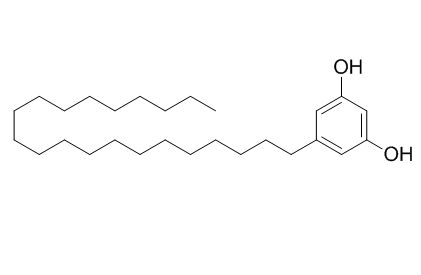5-Heneicosylresorcinol
5-Heneicosylresorcinol shows inhibitory effects on the release of β-hexosaminidase from RBL-2H3 cells, it also prevents triglyceride accumulation in 3T3-L1 cells. 5-Heneicosylresorcinol has nematicidal activity against nematodes Panagrellus redivivus, Caenothabditis elegans and Bursaphelenchus xylophilus, with ED50 values of 80, 30, and 180 ug/mL, respectively.
Inquire / Order:
manager@chemfaces.com
Technical Inquiries:
service@chemfaces.com
Tel:
+86-27-84237783
Fax:
+86-27-84254680
Address:
1 Building, No. 83, CheCheng Rd., Wuhan Economic and Technological Development Zone, Wuhan, Hubei 430056, PRC
Providing storage is as stated on the product vial and the vial is kept tightly sealed, the product can be stored for up to
24 months(2-8C).
Wherever possible, you should prepare and use solutions on the same day. However, if you need to make up stock solutions in advance, we recommend that you store the solution as aliquots in tightly sealed vials at -20C. Generally, these will be useable for up to two weeks. Before use, and prior to opening the vial we recommend that you allow your product to equilibrate to room temperature for at least 1 hour.
Need more advice on solubility, usage and handling? Please email to: service@chemfaces.com
The packaging of the product may have turned upside down during transportation, resulting in the natural compounds adhering to the neck or cap of the vial. take the vial out of its packaging and gently shake to let the compounds fall to the bottom of the vial. for liquid products, centrifuge at 200-500 RPM to gather the liquid at the bottom of the vial. try to avoid loss or contamination during handling.
Food Funct.2022, 13(13):6923-6933.
Separations2023, 10(2), 131.
Applied Biological Chemistry2023, 66(58):112.
Planta Med.2022, 88(9-10):794-804.
Korean Herb. Med. Inf.2020, 8(2):233-242.
PLoS One.2018, 13(4):e0195642
Biomed Pharmacother.2022, 145:112410.
South African Journal of Botany2021, 142:114-123.
Pharm Biol.2016, 54(7):1255-62
Food Chem.2022, 378:131975.
Related and Featured Products
J Agric Food Chem. 2004 Jan 28;52(2):246-50.
Inhibitory effect of natural phenolic lipids upon NAD-dependent dehydrogenases and on triglyceride accumulation in 3T3-L1 cells in culture.[Pubmed:
14733503 ]
Alkylresorcinols are phenolic lipids present at levels of 0.03-0.15% in wheat and rye grains and almost 10 times higher in respective bran products. Despite numerous studies on the influence of dietary fibers on the regulation of energy metabolism, this issue still remains controversial.
METHODS AND RESULTS:
The objective of our current studies was to investigate whether 5-n-alk(en)ylresorcinols, natural phenolic components of high fiber human diets, may be considered as natural regulators of excessive fat accumulation. Our studies revealed that 5-n-alk(en)ylresorcinols isolated from wheat and rye bran inhibit glycerol-3-phosphate dehydrogenase, the key enzyme in triglyceride synthesis in adipocytes, specifically and effectively. Further in vitro studies showed that these compounds also prevent triglyceride accumulation in 3T3-L1 cells.
CONCLUSIONS:
The most effective compound in both systems was 5-n-heneicosylresorcinol(5-Heneicosylresorcinol). The results indicate that the potential to prevent triglyceride accumulation increases with the hydrophobicity of the phenolic inhibitor.
Applied Biochemistry & Microbiology, 2016, 52(3):324-330.
Nematicidal metabolites from Gliocladium roseum YMF1.00133.[Reference:
WebLink]
A strain of the fungus Gliocladium roseum YMF1.00133 was found to secrete nematicidal metabolites against nematodes Panagrellus redivivus, Caenothabditis elegans and Bursaphelenchus xylophilus in experiments searching for nematicidal fungi.
METHODS AND RESULTS:
Through bioassay-guided fractionations, a unique trioxopiperazine alkaloid, gliocladin C (compound 1), and an alkylane resorcinol, 5-n-heneicosylresorcinol (5-Heneicosylresorcinol,compound 2) were obtained from the methanol extract of the fungus and determined by single-crystal X-ray analysis and spectroscopic data.
CONCLUSIONS:
In vitro immersion experiments showed that the ED50 values of compounds 1 and 2 after 24 h incubation were 15 and 30 μg/mL against C. elegans, 50 and 80 μg/mL against P. redivivus, and 200 and 180 μg/mL against B. xylophilus, respectively.
The X-ray diffraction data of compound 1 and the nematicidal activity of compounds 1 and 2 were reported for the first time.
Journal of the Korean Society for Applied Biological Chemistry, 2012, 55(1):69-74.
Inhibitors of antigen-induced degranulation of RBL-2H3 cells isolated from wheat bran.[Reference:
WebLink]
METHODS AND RESULTS:
Chromatographic separation of ethanol extract of wheat bran led to the isolation of five 5-alk(en)ylresorcinols, four aliphatic compounds, and one phenolic glycoside. These were, respectively: 5-n-heptadecylresorcinol (1), 5-n-14′-(Z)-heneicosylresorcinol (2), 5-n-nonadecylresorcinol (5-Nonadecylresorcinol,3), 5-n-heneicosylresorcinol (5-Heneicosylresorcinol ,4), 5-n-tricosylresorcinol (5), 1-O-(9Z,12Z,15Z-octadecatrienoate) glycerol (6), 2-linoleoylglycerol (7), 1-O-(9Z,12Z-octadecatrienoate)glycerol (8), pinellic acid (9), and tachioside (10). Their structures were determined by 1D- & 2D-NMR and mass spectroscopy data analysis.
CONCLUSIONS:
The inhibitory effects of isolated constituents on the release of β-hexosaminidase from RBL-2H3 cells were examined. Inhibition was shown by 5-n-nonadecylresorcinol (3), 5-n-heneicosylresorcinol (4), pinellic acid (9), and tachioside (10).



